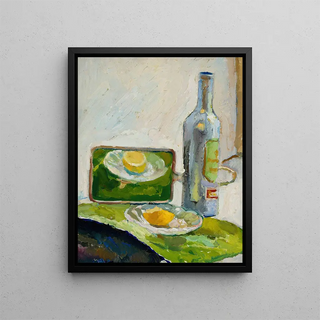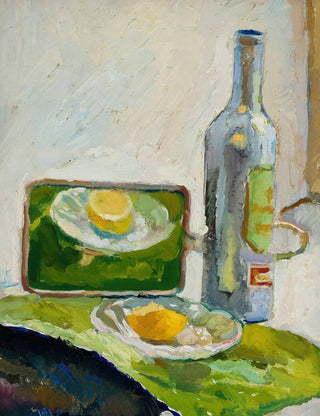Art print | Still life with bottle - Zygmunt Waliszewski


View from behind

Frame (optional)
Art print of Still Life with Bottle - Zygmunt Waliszewski – Captivating Introduction
The still life, a popular artistic genre since the 17th century, finds a particular resonance in the work of Zygmunt Waliszewski, titled "Still Life with Bottle." This piece, imbued with poetry and reflection, invites the viewer to immerse themselves in a world where each object, each color, each shadow tells a story. Waliszewski's carefully orchestrated composition transcends mere representation of inanimate objects to evoke deep emotions and buried memories. Contemplating this work, one immediately feels an atmosphere of serenity, as if time has frozen to allow silent introspection.
Style and uniqueness of the work
Waliszewski's style is distinguished by an impressive mastery of light and textures. In "Still Life with Bottle," subtle nuances of light reflecting on the bottle create a captivating play of shadows and highlights. The color palette chosen by the artist, oscillating between warm and cool tones, gives the piece a depth and an almost tactile dimension. The objects, though static, seem to vibrate with an inner life, as if they were silent witnesses to a personal story. The composition is also remarkable, each element carefully arranged to guide the viewer's gaze through the work, revealing unsuspected details with each contemplation.
The artist and his influence
Zygmunt Waliszewski, a Polish artist little known to the general public, has managed to establish himself through his unique approach to still life. Influenced by the old masters, he manages to infuse modernity into a genre often considered traditional. His ability to marry classical technique with contemporary sensitivity allows him to reach a wide audience. Waliszewski does not merely reproduce objects; he reinvents them, giving them new life and new meaning. His work reflects an era where art becomes a means of personal expression, a mirror of emotions and reflections on the world. Thus, "Still Life with Bottle" is not limited to a simple visual representation but becomes a true dialogue between the artist and

Matte finish

View from behind

Frame (optional)
Art print of Still Life with Bottle - Zygmunt Waliszewski – Captivating Introduction
The still life, a popular artistic genre since the 17th century, finds a particular resonance in the work of Zygmunt Waliszewski, titled "Still Life with Bottle." This piece, imbued with poetry and reflection, invites the viewer to immerse themselves in a world where each object, each color, each shadow tells a story. Waliszewski's carefully orchestrated composition transcends mere representation of inanimate objects to evoke deep emotions and buried memories. Contemplating this work, one immediately feels an atmosphere of serenity, as if time has frozen to allow silent introspection.
Style and uniqueness of the work
Waliszewski's style is distinguished by an impressive mastery of light and textures. In "Still Life with Bottle," subtle nuances of light reflecting on the bottle create a captivating play of shadows and highlights. The color palette chosen by the artist, oscillating between warm and cool tones, gives the piece a depth and an almost tactile dimension. The objects, though static, seem to vibrate with an inner life, as if they were silent witnesses to a personal story. The composition is also remarkable, each element carefully arranged to guide the viewer's gaze through the work, revealing unsuspected details with each contemplation.
The artist and his influence
Zygmunt Waliszewski, a Polish artist little known to the general public, has managed to establish himself through his unique approach to still life. Influenced by the old masters, he manages to infuse modernity into a genre often considered traditional. His ability to marry classical technique with contemporary sensitivity allows him to reach a wide audience. Waliszewski does not merely reproduce objects; he reinvents them, giving them new life and new meaning. His work reflects an era where art becomes a means of personal expression, a mirror of emotions and reflections on the world. Thus, "Still Life with Bottle" is not limited to a simple visual representation but becomes a true dialogue between the artist and






